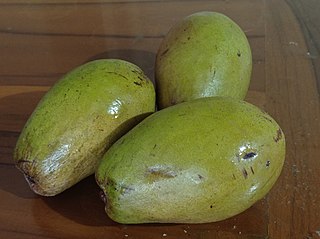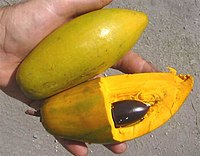
The persimmon is the edible fruit of a number of species of trees in the genus Diospyros. The most widely cultivated of these is the kaki persimmon, Diospyros kaki – Diospyros is in the family Ebenaceae, and a number of non-persimmon species of the genus are grown for ebony timber. In 2022, China produced 77% of the world total of persimmons.

The Sapotaceae are a family of flowering plants belonging to the order Ericales. The family includes about 800 species of evergreen trees and shrubs in around 65 genera. Their distribution is pantropical.

Manilkara zapota, commonly known as sapodilla, sapote, chicozapote, chicoo, chicle, naseberry, nispero, or soapapple, among other names, is an evergreen tree native to southern Mexico and Central America. An example natural occurrence is in coastal Yucatán, in the Petenes mangroves ecoregion, where it is a subdominant plant species. It was introduced to the Philippines during Spanish colonization. It is grown in large quantities in Mexico and in tropical Asia, including India, Pakistan, Thailand, Malaysia, Cambodia, Indonesia, Vietnam, Bangladesh, as well as in the Caribbean.

Mammea americana, commonly known as mammee, mammee apple, mamey, mamey apple, Santo Domingo apricot, tropical apricot, or South American apricot, is an evergreen tree of the family Calophyllaceae, whose fruit is edible. It has also been classified as belonging to the family Guttiferae Juss. (1789), which would make it a relative of the mangosteen.

The Fruit & Spice Park, formally known as the Preston B. Bird/Mary Heinlein Fruit & Spice Park, is a 37-acre park located in Redland, Florida, and it is the only botanical garden of its kind in the United States. This park is operated by Miami-Dade County Parks and Open Spaces Department. The park attracts more than 50,000 visitors per year because of its unique agricultural environment. The garden features more than 500 different types of international exotic fruits, vegetables, herbs, and spices. Visitors are allowed to sample fallen fruits, have lunch at the Mango Cafe, or schedule a tour of the park.

Sapote is a term for a soft, edible fruit. The word is incorporated into the common names of several unrelated fruit-bearing plants native to Mexico, Central America and northern parts of South America. It is also known in Caribbean English as soapapple.

Pouteria is a genus of flowering trees in the gutta-percha family, Sapotaceae. The genus is widespread throughout the tropical Americas, with outlier species in Cameroon and Malesia. It includes the canistel, the mamey sapote, and the lucuma. Commonly, this genus is known as pouteria trees, or in some cases, eggfruits.

Pouteria sapota, the mamey sapote, is a species of tree native to Mexico and Central America. The tree is also cultivated in the Caribbean. Its fruit is eaten in many Latin American countries. The fruit is made into foods such as milkshakes and ice cream.

Pouteria lucuma is a species of tree in the family Sapotaceae, cultivated for its fruit, the lúcuma. It is native to the Andean valleys of Bolivia, Ecuador, Chile and Peru.

Mangifera caesia is a species of flowering plant in the cashew family, Anacardiaceae. Known in English as jack or white mango, among other names. It belongs to the same genus as the mango and is widely cultivated in areas of Indonesia, Malaysia, Singapore, Brunei, Papua New Guinea and the Philippines.

Pouteria caimito, the abiu, is a tropical fruit tree originating in the Amazonian region of South America, and this type of fruit can also be found in the Philippines and other countries in Southeast Asia. It grows to an average of 10 metres high, with ovoid fruits. The inside of the fruit is translucent and white. It has a creamy and jelly-like texture with a taste resembling caramel custard.†

The white sapote, scientific name Casimiroa edulis, also called casimiroa and Mexican apple, and known as cochitzapotl in the Nahuatl language is a species of tropical fruiting tree in the family Rutaceae, native to eastern Mexico and Central America south to Costa Rica. The genus is named for "an Otomi Indian, Casimiro Gómez, from the town of Cardonal in Hidalgo, Mexico, who fought and died in Mexico's war of independence."

Diospyros kaki, the Oriental persimmon, Chinese persimmon, Japanese persimmon or kaki persimmon, is the most widely cultivated species of the genus Diospyros. Although its first botanical description was not published until 1780, D. kaki cultivation in China dates back more than 2000 years.
Pouteria dominigensis is a species of plant in the family Sapotaceae. It is native to Cuba, Hispaniola, the Bahamas, and Florida. It is threatened by habitat loss. This plant produces a round yellow fruit with an exotic flavor, a mixture between Pouteria campechiana, canistel, & Carica papaya. The pulp has with a sweet texture and is similar Pouteria campechiana. This fruit, commonly referred to as the egg-fruit due to its association with the aforementioned and more commonly known Pouteria campechiana, is what the plant is cultivated and collected for.

Planchonella australis, also known by the synonym Pouteria australis, is a medium to tall rainforest tree of the family Sapotaceae native to Queensland and New South Wales, Australia. It is known by the common name black apple, wild plum, yellow buttonwood, black plum and yellow bulletwood.

Manilkara huberi, also known as masaranduba, níspero, and sapotilla, is a fruit bearing plant of the genus Manilkara of the family Sapotaceae.

Pouteria viridis is a species of flowering plant in the family Sapotaceae known by the common name green sapote.

Casimiroa is a genus of flowering plants in the family Rutaceae. It includes about 10 species native to Mexico and Central America. The genus is named for "an Otomi Indian, Casimiro Gómez, from the town of Cardonal in Hidalgo, Mexico, who fought and died in Mexico's war of independence."
Zapote amarillo is a common name for three separate tree species native to Central America:
Couepia polyandra, also known as olosapo, zapote amarillo, baboon cap, and monkey cap, is a flowering tree in the family Chrysobalanaceae.
























